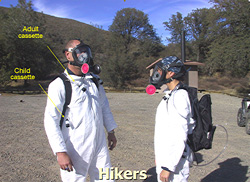Pacific Southwest, Region 9
Serving: Arizona, California, Hawaii, Nevada, Pacific Islands, Tribal Nations
Naturally Occurring Asbestos
Clear Creek Management Area
Exposure Assessment


Asbestos Air Sampling
In 2004 and 2005, EPA collected air samples while EPA employees and contractors participated in typical recreational activities at the Clear Creek Management Area. The samples were collected from the breathing zone of individuals riding motorcycles and all-terrain vehicles (ATV), driving and riding in sports utility vehicles (SUV), hiking, camping, sleeping in tents, fence building, and washing and vacuuming vehicles after use at CCMA. Sample cassettes were placed to collect air samples representing the breathing zone heights of both adults and children (Photo 1) and samples were collected for both lead and trailing riders (Photo 2). These activity-based air samples were then analyzed for asbestos.
The EPA Exposure and Human Health Risk Assessment report was released on May 1, 2008.
Results
It is important to note that the asbestos concentrations used by EPA in the exposure and risk assessment and discussed in this fact sheet are for longer fibers known as phase contrast microscopy equivalent, or PCME, fibers. PCME fibers are those fibers with a shape and size that have been most closely linked to asbestos disease.
Figure 1
The Activity Drives the Exposure- Figure 1 shows the individual sample results for each activity and for measurements of CCMA ambient air. The data shows that the activities which typically create the most soil disturbance and dust, motorcycling, ATV driving/riding, and SUV driving/riding, also release the most asbestos into the breathing zone. In some instances, the concentration of asbestos measured in the EPA samples even exceeded what the U.S. Occupational Safety and Health Administration (OSHA) sets for workers as a 30-minute limit for asbestos.
Figure 2
Position Is Important - Figure 2 shows the results for motorcycle riders in the lead and trailing behind and for ATV and SUV drivers/riders. First trailing drivers/riders encountered higher asbestos air concentrations than lead drivers/riders and second trailing drivers/riders typically encountered higher levels than first trailing. This means that the asbestos levels in the air increased with the larger dust clouds encountered by those riders following one or more riders ahead of them.
Figure 3
Figure 4
SUV Exposures Were Significant – As shown in Figure 4, driving on the unpaved CCMA access roads resulted in significant measured asbestos air concentrations inside the vehicles, even with the windows closed and the air system set to “recirculate”.
Figure 5
Amphibole Asbestos Was Detected in the Air Samples – While chrysotile asbestos was the predominant asbestos mineral type found in the EPA air samples, almost 8% of the PCME fibers were identified as tremolite, actinolite, or another amphibole asbestos mineral. There is an emerging consensus in the scientific community that amphibole asbestos may present an ever greater health risk.
| Region 9 NewsroomRegion 9 Programs | Grants & FundingUS-Mexico Border | Media CenterCareers | About Region 9A-Z Index |
